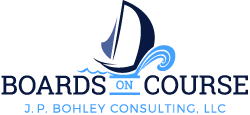Tip #45 Plan for Board Team Effectiveness: The Third "P" for Building Your Board Team
We have identified 4 P’s for Building Your Board Team: Purpose, People, Plan and Process. After covering the first 2 P’s in our last two Tips for Effective Boards, we now turn to the third P: Plan and Organize for Board Team Effectiveness.
Planning and Organizing for Board Team Effectiveness can involve the following:
Structure the critical Board-CEO relationship to create a foundation for a highly constructive and productive relationship. Clarify the roles of the board and the CEO and the scope of authority delegated to the CEO. Clearly state the board’s expectations of the CEO and monitor CEO performance only against these expectations. Provide competitive and fair CEO compensation. Commit to ongoing learning for both board and CEO.
Embrace the group authority principle. Recognize that no individual board member not even the board chair supervises the CEO. Rather, the board acts as a whole in directing the CEO. That is, the CEO does not have many bosses (who may disagree with one another) but one boss, the board deciding and acting as a whole in clearly stating its expectations of the CEO.
Structure committees to support board work not staff work. First, be clear about what constitutes board work and what constitutes CEO/staff work. Align board committees with the work of the board (linking with key stakeholders/owners, establishing operational expectations and expectations for the board itself, ensuring compliance with its expectations, other tasks it may reserve to itself such as fundraising and advocacy). Be wary of aligning board committees with operational functions (e.g., finance, marketing, programs, etc.). Board committees aligned with operational functions undercut the authority delegated to the CEO as well as the accountability of the CEO to the board.
Structure board terms and term limits to balance experienced board members with an influx of new board members. Allow board members to stay on the board long enough to learn the ropes and make positive contributions but not so long that their performance declines or that there are not opportunities for new board members to join the board with their new ideas and fresh energy. According to BoardSource the most common board member term length for non-profit boards is three years and the most common maximum number of terms is two. (BoardSource, Leading with Intent, 2017, p. 18.)
Secure adequate administrative support. Have regular meeting space that is pleasant and functional as well as occasional access to alternate space for special board meetings/retreats. Ensure staff clerical support for the preparation of meeting minutes, meeting notifications and other communications. Approve annual financial support for ongoing board and board member continuing education and important board functions (e.g., meetings and other communications with key organizational stakeholders/owners.)
Explore the Policy Governance® model. This comprehensive model provides a board governance design that promotes board efficiency, board effectiveness (results-driven), accountability of CEO to board and board to the organization’s key stakeholders/owners, and clearly defines the critical board-CEO relationship in a way that effectively balances board control and CEO empowerment. For more information about the Policy Governance® system, please click on https://www.BoardsOnCourse.com/policy-governance or contact me at jpbohley@gmail.com.
In our next Tip for Effective Boards, we’ll focus on the fourth P for building your board team: Manage Board Group Process Effectively.
While the 4 P’s incorporate insights from the Policy Governance® system, the 4 P’s also draw from other governance writers and from the group dynamics and team-building literature.
I will be happy to customize a workshop for your board on any or all of the 4 P’s or on the Policy Governance® system which provides an excellent governance design for the 4 P’s. If you would like more information, please contact me via the Contact Us page of this website or via email: jpbohley@gmail.com.
